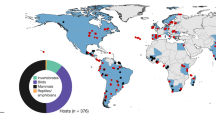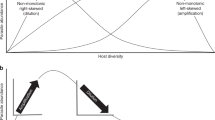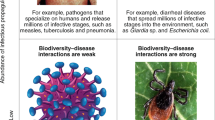Abstract
Increasingly intimate associations between human society and the natural environment are driving the emergence of novel pathogens, with devastating consequences for humans and animals alike. Prior to emergence, these pathogens exist within complex ecological systems that are characterized by trophic interactions between parasites, their hosts and the environment. Predicting how disturbance to these ecological systems places people and animals at risk from emerging pathogens—and the best ways to manage this—remains a significant challenge. Predictive systems ecology models are powerful tools for the reconstruction of ecosystem function but have yet to be considered for modelling infectious disease. Part of this stems from a mistaken tendency to forget about the role that pathogens play in structuring the abundance and interactions of the free-living species favoured by systems ecologists. Here, we explore how developing and applying these more complete systems ecology models at a landscape scale would greatly enhance our understanding of the reciprocal interactions between parasites, pathogens and the environment, placing zoonoses in an ecological context, while identifying key variables and simplifying assumptions that underly pathogen host switching and animal-to-human spillover risk. As well as transforming our understanding of disease ecology, this would also allow us to better direct resources in preparation for future pandemics.
This is a preview of subscription content, access via your institution
Access options
Access Nature and 54 other Nature Portfolio journals
Get Nature+, our best-value online-access subscription
$29.99 / 30 days
cancel any time
Subscribe to this journal
Receive 12 digital issues and online access to articles
$119.00 per year
only $9.92 per issue
Buy this article
- Purchase on Springer Link
- Instant access to full article PDF
Prices may be subject to local taxes which are calculated during checkout




Similar content being viewed by others
Change history
26 May 2021
A Correction to this paper has been published: https://doi.org/10.1038/s41559-021-01495-z
References
Allen, T. et al. Global hotspots and correlates of emerging zoonotic diseases. Nat. Commun. 8, 1124 (2017).
Gibb, R. et al. Zoonotic host diversity increases in human-dominated ecosystems. Nature 584, 398–402 (2020).
Hassell, J. M., Begon, M., Ward, M. J. & Fèvre, E. M. Urbanization and disease emergence: dynamics at the wildlife–livestock–human interface. Trends Ecol. Evol. 32, 55–67 (2017).
Plowright, R. K. et al. Pathways to zoonotic spillover. Nat. Rev. Microbiol. 15, 502–510 (2017).
Holmes, E. C., Rambaut, A. & Andersen, K. G. Pandemics: spend on surveillance, not prediction comment. Nature 558, 180–182 (2018).
Tabachnick, W. J. Challenges in predicting climate and environmental effects on vector-borne disease episystems in a changing world. J. Exp. Biol. 213, 946–954 (2010).
Franklinos, L. H. V., Jones, K. E., Redding, D. W. & Abubakar, I. The effect of global change on mosquito-borne disease. Lancet Inf. Dis. 19, e302–e312 (2019).
Seabloom, E. W. et al. The community ecology of pathogens: coinfection, coexistence and community composition. Ecol. Lett. 18, 401–415 (2015).
Johnson, P. T. J., De Roode, J. C. & Fenton, A. Why infectious disease research needs community ecology. Science 349, 1259504 (2015).
Parker, I. M. et al. Phylogenetic structure and host abundance drive disease pressure in communities. Nature 520, 542–544 (2015).
Telfer, S. et al. Species interactions in a parasite community drive infection risk in a wildlife population. Science 330, 243–246 (2010).
Dallas, T. A., Laine, A.-L. L. & Ovaskainen, O. Detecting parasite associations within multi-species host and parasite communities. Proc. R. Soc. B 286, 20191109 (2019).
Weinstein, S., Titcomb, G., Agwanda, B., Riginos, C. & Young, H. Parasite responses to large mammal loss in an African savanna. Ecology 98, 1839–1848 (2017).
Anderson, R. & May, R. Infectious Diseases of Humans: Dynamics and Control (Oxford Univ. Press, 1992).
Keeling, M. J. & Rohani, P. Modeling Infectious Diseases in Humans and Animals (Princeton Univ. Press, 2011).
Buhnerkempe, M. G. et al. Eight challenges in modelling disease ecology in multi-host, multi-agent systems. Epidemics 10, 26–30 (2014).
Cross, P. C., Prosser, D. J., Ramey, A. M., Hanks, E. M. & Pepin, K. M. Confronting models with data: the challenges of estimating disease spillover. Philos. Trans. R. Soc. B 374, 20180435 (2019).
Johnson, E. E., Escobar, L. E. & Zambrana-Torrelio, C. An ecological framework for modeling the geography of disease transmission. Trends Ecol. Evol. 34, 655–668 (2019).
Warton, D. I. et al. So many variables: joint modeling in community ecology. Trends Ecol. Evol. 30, 766–779 (2015).
Carlson, C. J. et al. The global distribution of Bacillus anthracis and associated anthrax risk to humans, livestock and wildlife. Nat. Microbiol. 4, 1337–1343 (2019).
Sutherland, W. J. Predicting the ecological consequences of environmental change: a review of the methods. J. Appl. Ecol. 43, 599–616 (2006).
Getz, W. M. et al. Making ecological models adequate. Ecol. Lett. 21, 153–166 (2018).
Carlson, C. J., Chipperfield, J. D., Benito, B. M., Telford, R. J. & O’Hara, R. B. Species distribution models are inappropriate for COVID-19. Nat. Ecol. Evol. 4, 770–771 (2020).
Evans, M. R. et al. Predictive systems ecology. Proc. R. Soc. B 280, 20131452 (2013).
Purves, D. & Pacala, S. Predictive models of forest dynamics. Science 320, 1452–1453 (2008).
Harfoot, M. B. J. et al. Emergent global patterns of ecosystem structure and function from a mechanistic general ecosystem model. PLoS Biol. 12, e1001841 (2014).
Lafferty, K. D. et al. Parasites in food webs: the ultimate missing links. Ecol. Lett. 11, 533–546 (2008).
Redding, D. W. et al. Impacts of environmental and socio-economic factors on emergence and epidemic potential of Ebola in Africa. Nat. Commun. 10, 4531 (2019).
Redding, D. W., Moses, L. M., Cunningham, A. A., Wood, J. & Jones, K. E. Environmental-mechanistic modelling of the impact of global change on human zoonotic disease emergence: a case study of Lassa fever. Methods Ecol. Evol. 7, 646–655 (2016).
Carlson, C. J., Dallas, T. A., Alexander, L. W., Phelan, A. L. & Phillips, A. J. What would it take to describe the global diversity of parasites? Proc. R. Soc. B 287, 20201841 (2020).
Rynkiewicz, E. C., Pedersen, A. B. & Fenton, A. An ecosystem approach to understanding and managing within-host parasite community dynamics. Trends Parasitol. 31, 212–221 (2015).
Lello, J. & Hussell, T. Functional group/guild modelling of inter-specific pathogen interactions: a potential tool for predicting the consequences of co-infection. Parasitology 135, 825–839 (2008).
Purves, D. et al. Time to model all life on Earth. Nature 493, 295–297 (2013).
Kalka, M. B., Smith, A. R. & Kalko, E. K. V. Bats limit arthropods and herbivory in a tropical forest. Science 320, 71 (2008).
Lafferty, K. D. et al. A general consumer-resource population model. Science 349, 854–857 (2015).
Friedman, J., Higgins, L. M. & Gore, J. Community structure follows simple assembly rules in microbial microcosms. Nat. Ecol. Evol. 1, 0109 (2017).
Goldford, J. E. et al. Emergent simplicity in microbial community assembly. Science 361, 469–474 (2018).
Hatton, I. A. et al. The predator-prey power law: biomass scaling across terrestrial and aquatic biomes. Science 349, 6252 (2015).
Hatton, I. A., Dobson, A. P., Storch, D., Galbraith, E. D. & Loreau, M. Linking scaling laws across eukaryotes. Proc. Natl Acad. Sci. USA 116, 21616 (2019).
Locey, K. J. & Lennon, J. T. Scaling laws predict global microbial diversity. Proc. Natl Acad. Sci. USA 113, 5970–5975 (2016).
Godon, J. J., Arulazhagan, P., Steyer, J. P. & Hamelin, J. Vertebrate bacterial gut diversity: size also matters. BMC Ecol. 16, 12 (2016).
Faust, C. L. et al. Null expectations for disease dynamics in shrinking habitat: dilution or amplification? Philos. Trans. R. Soc. B 372, 20160173 (2017).
De Leo, G. A. & Dobson, A. P. Allometry and simple epidemic models for microparasites. Nature 379, 720–722 (1996).
Strauss, A. T., Shoemaker, L. G., Seabloom, E. W. & Borer, E. T. Cross‐scale dynamics in community and disease ecology: relative timescales shape the community ecology of pathogens. Ecology 100, e02836 (2019).
Handel, A. & Rohani, P. Crossing the scale from within-host infection dynamics to between-host transmission fitness: A discussion of current assumptions and knowledge. Philos. Trans. R. Soc. B 370, 20140302 (2015).
Tibayrenc, M. & Ayala, F. J. Reproductive clonality of pathogens: a perspective on pathogenic viruses, bacteria, fungi, and parasitic protozoa. Proc. Natl Acad. Sci. USA 109, E3305–E3313 (2012).
Gorter, F. A., Manhart, M. & Ackermann, M. Understanding the evolution of interspecies interactions in microbial communities. Philos. Trans. R. Soc. B 375, 1798 (2020).
Zeng, Q., Wu, S., Sukumaran, J. & Rodrigo, A. Models of microbiome evolution incorporating host and microbial selection. Microbiome 5, 127 (2017).
Zeng, Q., Sukumaran, J., Wu, S. & Rodrigo, A. Neutral models of microbiome evolution. PLoS Comput. Biol. 11, e1004365 (2015).
Liautaud, K., van Nes, E. H., Barbier, M., Scheffer, M. & Loreau, M. Superorganisms or loose collections of species? A unifying theory of community patterns along environmental gradients. Ecol. Lett. 22, 1243–1252 (2019).
Coyte, K. Z., Schluter, J. & Foster, K. R. The ecology of the microbiome: Networks, competition, and stability. Science 350, 663–666 (2015).
Wright, E. S. & Vetsigian, K. H. Inhibitory interactions promote frequent bistability among competing bacteria. Nat. Commun. 7, 11274 (2016).
Hekstra, D. R. & Leibler, S. Contingency and statistical laws in replicate microbial closed ecosystems. Cell 149, 1164–1173 (2012).
Lopatkin, A. J. & Collins, J. J. Predictive biology: modelling, understanding and harnessing microbial complexity. Nat. Rev. Microbiol. 18, 507–520 (2020).
Sanchez, A. & Gore, J. Feedback between population and evolutionary dynamics determines the fate of social microbial populations. PLoS Biol. 11, e1001547 (2013).
Wu, F. et al. A unifying framework for interpreting and predicting mutualistic systems. Nat. Commun. 10, 242 (2019).
Restif, O. et al. Model-guided fieldwork: practical guidelines for multidisciplinary research on wildlife ecological and epidemiological dynamics. Ecol. Lett. 15, 1083–1094 (2012).
Herzog, S. A., Blaizot, S. & Hens, N. Mathematical models used to inform study design or surveillance systems in infectious diseases: a systematic review. BMC Infect. Dis. 17, 1–10 (2017).
Cotterill, G. G. et al. Winter feeding of elk in the Greater Yellowstone Ecosystem and its effects on disease dynamics. Philos. Trans. R. Soc. B 373, 20170093 (2018).
Cross, P. C. et al. Estimating distemper virus dynamics among wolves and grizzly bears using serology and Bayesian state-space models. Ecol. Evol. 8, 8726–8735 (2018).
Hopkins, J. B., Ferguson, J. M., Tyers, D. B. & Kurle, C. M. Selecting the best stable isotope mixing model to estimate grizzly bear diets in the Greater Yellowstone Ecosystem. PLoS ONE 12, e0174903 (2017).
Schwartz, C. C. et al. Body and diet composition of sympatric black and grizzly bears in the Greater Yellowstone Ecosystem. J. Wildl. Manag. 78, 68–78 (2014).
Chester, C. C. Yellowstone to Yukon: transborder conservation across a vast international landscape. Environ. Sci. Policy 49, 75–84 (2015).
Young, H. S. et al. Interacting effects of land use and climate on rodent-borne pathogens in central Kenya. Philos. Trans. R. Soc. B 372, 20160116 (2017).
Sitters, J., Kimuyu, D. M., Young, T. P., Claeys, P. & Olde Venterink, H. Negative effects of cattle on soil carbon and nutrient pools reversed by megaherbivores. Nat. Sustain. 3, 360–366 (2020).
Sethi, S. S., Ewers, R. M., Jones, N. S., Orme, C. D. L. & Picinali, L. Robust, real‐time and autonomous monitoring of ecosystems with an open, low‐cost, networked device. Methods Ecol. Evol. 9, 2383–2387 (2018).
Alfano, N., Dayaram, A. & Tsangaras, K. Non-invasive surveys of mammalian viruses using environmental DNA. Preprint at bioRxiv https://doi.org/10.1101/2020.03.26.009993 (2020)
Coyte, K. Z. & Rakoff-Nahoum, S. Understanding competition and cooperation within the mammalian gut microbiome. Curr. Biol. 29, R538–R544 (2019).
Murray, M. H. et al. Gut microbiome shifts with urbanization and potentially facilitates a zoonotic pathogen in a wading bird. PLoS ONE 15, e0220926 (2020).
McCallum, H. I. et al. Does terrestrial epidemiology apply to marine systems? Trends Ecol. Evol. 19, 585–591 (2004).
Wu, S., Carvalho, P. N., Müller, J. A., Manoj, V. R. & Dong, R. Sanitation in constructed wetlands: a review on the removal of human pathogens and fecal indicators. Sci. Total Environ. 541, 8–22 (2016).
Lamb, J. B. et al. Seagrass ecosystems reduce exposure to bacterial pathogens of humans, fishes, and invertebrates. Science 355, 731–733 (2017).
Janssen, M. A., Walker, B. H., Langridge, J. & Abel, N. An adaptive agent model for analysing co-evolution of management and policies in a complex rangeland system. Ecol. Model. 131, 249–268 (2000).
Ngonghala, C. N. et al. General ecological models for human subsistence, health and poverty. Nat. Ecol. Evol. 1, 1153–1159 (2017).
Hosseini, P. R. et al. Does the impact of biodiversity differ between emerging and endemic pathogens? The need to separate the concepts of hazard and risk. Philos. Trans. R. Soc. B 372, 20160129 (2017).
Washburne, A. D. et al. Percolation models of pathogen spillover. Philos. Trans. R. Soc. B 374, 20180331 (2019).
Olival, K. J. et al. Host and viral traits predict zoonotic spillover from mammals. Nature 546, 646–650 (2017).
Dobson, A. et al. Habitat loss, trophic collapse, and the decline of ecosystem services. Ecology 87, 1915–1924 (2006).
Faust, C. L. et al. Pathogen spillover during land conversion. Ecol. Lett. 21, 471–483 (2018).
Sokolow, S. H. et al. Ecological interventions to prevent and manage zoonotic pathogen spillover. Philos. Trans. R. Soc. B 374, 20180342 (2019).
Kauffman, M. J. et al. Landscape heterogeneity shapes predation in a newly restored predator-prey system. Ecol. Lett. 10, 690–700 (2007).
Smith, D. W., Peterson, R. O. & Houston, D. B. Yellowstone after wolves. BioScience 53, 330–340 (2003).
McNaughton, S. J. Ecology of a grazing ecosystem: the Serengeti. Ecol. Monogr. 55, 259–294 (1985).
Atkins, J. L. et al. Cascading impacts of large-carnivore extirpation in an African ecosystem. Science 364, 173–177 (2019).
Cross, P. C., Edwards, W. H., Scurlock, B. M., Maichak, E. J. & Rogerson, J. D. Effects of management and climate on elk brucellosis in the Greater Yellowstone Ecosystem. Ecol. Appl. 17, 957–964 (2007).
Almberg, E. S., Cross, P. C. & Smith, D. W. Persistence of canine distemper virus in the Greater Yellowstone Ecosystem’s carnivore community. Ecol. Appl. 20, 2058–2074 (2010).
Holdo, R. M. et al. A disease-mediated trophic cascade in the Serengeti and its implications for ecosystem C. PLoS Biol. 7, e1000210 (2009).
Borer, E. T. in Unsolved Problems in Ecology (eds Dobson, A. P. et al.) 3–15 (Princeton Univ. Press, 2020).
Kao, R. H. et al. NEON terrestrial field observations: designing continental-scale, standardized sampling. Ecosphere https://doi.org/10.1890/ES12-00196.1 (2012).
Springer, Y. P. et al. Tick-, mosquito-, and rodent-borne parasite sampling designs for the National Ecological Observatory Network. Ecosphere 7, e01271 (2016).
Anderson-Teixeira, K. J. et al. CTFS-ForestGEO: a worldwide network monitoring forests in an era of global change. Glob. Chang. Biol. 21, 528–549 (2015).
Dobson, A. P. et al. Ecology and economics for pandemic prevention. Science 369, 379–381 (2020).
Kress, W. J., Mazet, J. A. K. & Hebert, P. D. N. Opinion: intercepting pandemics through genomics. Proc. Natl Acad. Sci. USA 117, 202009508 (2020).
Durmuş, S. & Ülgen, K. Comparative interactomics for virus–human protein–protein interactions: DNA viruses versus RNA viruses. FEBS Open Bio 7, 96–107 (2017).
Becker, D. J. & Albery, G. F. Expanding host specificity and pathogen sharing beyond viruses. Mol. Ecol. 29, 3170–3172 (2020).
Rittershaus, E. S. C., Baek, S. H. & Sassetti, C. M. The normalcy of dormancy: common themes in microbial quiescence. Cell Host Microbe 13, 643–651 (2013).
Pedersen, A. B. & Fenton, A. Emphasizing the ecology in parasite community ecology. Trends Ecol. Evol. 22, 133–139 (2007).
Schmid-Hempel, P. Immune defence, parasite evasion strategies and their relevance for ‘macroscopic phenomena’ such as virulence. Philos. Trans. R. Soc. B 364, 85–98 (2009).
Plowright, R. K. et al. Land use-induced spillover: a call to action to safeguard environmental, animal, and human health. Lancet Planet. 5, E237–E245 (2021).
Barychka, T., Mace, G. & Purves, D. The Madingley General Ecosystem Model predicts bushmeat yields, species extinction rates and ecosystem-level impacts of bushmeat harvesting. Preprint at biorXiv https://doi.org/10.1101/2020.03.02.959718 (2020).
Acknowledgements
J.H., D.Z. and Y.-M.L. were supported by the US Army Medical Research and Development Command under contract no. W81XWH-21-C-0001 and the Armed Forces Health Surveillance Division, Global Emerging Infections Surveillance branch (AFHSC-GEIS) award P0031_21_WR. The views, opinions and/or findings contained in this report are those of the author(s) and should not be construed as an official Department of the Army position, policy or decision unless so designated by other documentation. T.N. is supported by two grants from the Leverhulme Trust (RPG-2015-073 and RPG-2018-069). L.H.V.F. is supported by the Natural Environment Research Council (NE-J001570–1).
Author information
Authors and Affiliations
Contributions
J.M.H. conceptualized the structure and content of the manuscript and wrote an initial draft. J.M.H., T.N., A.P.D., Y.-M.L., L.V.H.F., D.Z. and K.M.P.L. expanded upon the ideas contained within this initial draft, and engaged in discussion and editing of the final manuscript.
Corresponding author
Ethics declarations
Competing interests
The authors declare no competing interests.
Additional information
Peer review information Nature Ecology & Evolution thanks Kim Pepin and the other, anonymous, reviewer(s) for their contribution to the peer review of this work.
Publisher’s note Springer Nature remains neutral with regard to jurisdictional claims in published maps and institutional affiliations.
Rights and permissions
About this article
Cite this article
Hassell, J.M., Newbold, T., Dobson, A.P. et al. Towards an ecosystem model of infectious disease. Nat Ecol Evol 5, 907–918 (2021). https://doi.org/10.1038/s41559-021-01454-8
Received:
Accepted:
Published:
Issue Date:
DOI: https://doi.org/10.1038/s41559-021-01454-8
This article is cited by
-
Adapting modeling and simulation credibility standards to computational systems biology
Journal of Translational Medicine (2023)
-
Model-based surveillance system design under practical constraints with application to white-nose syndrome
Environmental and Ecological Statistics (2023)
-
Viruses of Atlantic Bonefish (Albula vulpes) in Florida and the Caribbean show geographic patterns consistent with population declines
Environmental Biology of Fishes (2023)
-
A strategy to assess spillover risk of bat SARS-related coronaviruses in Southeast Asia
Nature Communications (2022)
-
Managing host-parasite interactions in humans and wildlife in times of global change
Parasitology Research (2022)



